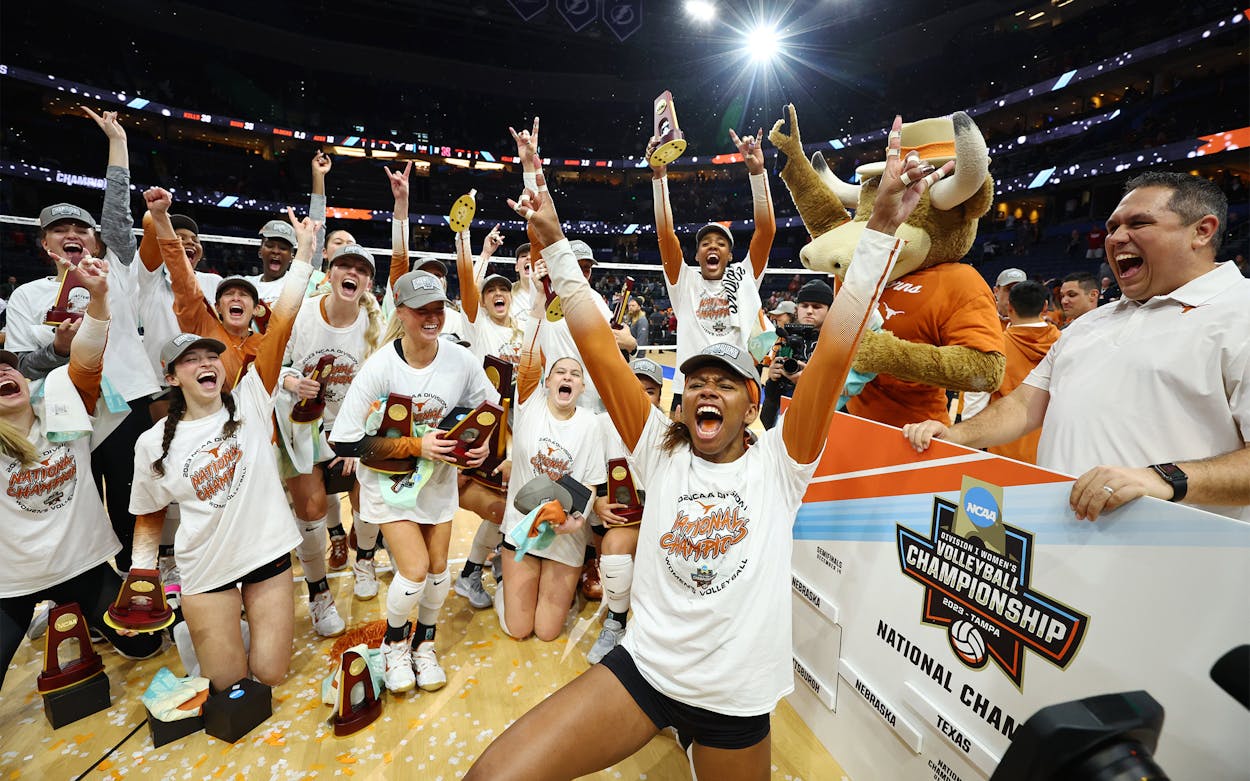It was just after midnight on Monday when the bus carrying the Texas Longhorns national-champion volleyball team pulled back onto campus. By then, the UT Tower in Austin was bathed in a celebratory burnt orange spotlight, and the party was going strong as the champs deboarded with the trophy they’d buckled into its own seat for the return flight from Tampa.
“It’s what you work for, right?” Texas coach Jerritt Elliott told me later that day. “I mean, it’s what you talk about with all the recruits and with your players. Everybody knows what that [lighted Tower] means, and that’s super special.”
Asjia O’Neal, one of the best players in the world, had passed up an opportunity to turn pro because she wanted to try and win a second straight national championship. She’d slammed home five of UT’s finals-record twelve service aces in the championship match against Nebraska, and during the victory celebration, she could have passed for the happiest person on the planet.
“I don’t think I have ever had a run like that,” O’Neal said at the post-match news conference. “Before the game, I said, ‘I feel kinda weird with my serve today.’ But . . . it really goes back to our team culture and how everyone really uplifts one another and allows us to do kind of crazy things.”
She was surrounded by talent, from outside hitter Madisen Skinner to freshman setter Ella Swindle to sophomore libero Emma Halter, among others, all of whom had formed a team that dominated traditional women’s volleyball power Nebraska in the championship. Texas won a close opening match 25–22 and trailed 10–7 in the second before taking over. The Longhorns won the second set 25–14 and the third 25–11. Skinner, Swindle, and Keonilei Akana had two service aces apiece.
“They had a level of serving we haven’t seen all year,” Nebraska coach John Cook told reporters. “That really impacted us in our momentum and our confidence. . . . They got all the momentum, and we could never get it back.”
That these Longhorns would win a second consecutive national championship didn’t seem realistic just four months ago when they opened this season with a loss to unranked Long Beach State and carried a 5–3 match record into mid-September.
This wasn’t what had been forecast when O’Neal announced she would return to school and Elliott added an assortment of gifted freshmen and transfers to a solid core of returning players. For Texas, a program that has made the Elite Eight in seventeen of the last eighteen seasons, expectations can sometimes become stifling. “I just think it’s really hard to sustain,” Elliott told me. “And it puts a lot of stress on [the players]. I do it internally because I know the standard that we’ve created. If Texas doesn’t make a Final Four, it’s a terrible year. That’s really sad that’s where sports have gone, but it’s also the effect of all the success that we’ve had.
“I don’t know if any of us knew that we were gonna get this good by the end of the year,” he went on. “We all stuck with it. We stuck with the process, and we gave ourselves an opportunity and built trust with the team. They just kept developing and, ultimately, they took off.”
But that slow start created a different dynamic. “We were the underdogs all season,” Skinner said. “All the pressure was on everybody else that had returning people.”
Slow down on the underdog talk. As Elliott said, “When you put on a Texas uniform, you’re usually not the underdog. Internally, we knew we were a great team, and we could win this, and that was all that mattered.”
The Longhorns won seventeen of eighteen matches to finish the regular season. Over the team’s final seven victories, it lost just one set. Then the Longhorns defeated Texas A&M and SMU in the opening two rounds of the NCAA tournament and bested Tennessee and Stanford in the regionals to return to the Final Four. “We go against the best players in the country every single day in practice,” Swindle said.
After the championship match, Cook, the Nebraska coach, criticized how the Longhorns assembled their roster, saying: “You look at tonight’s match. Half their starting team are transfers. They’re all fourth- and fifth-year players except for Ella [Swindle]. . . . That’s how they’ve been building their team. That’s how they built last year’s team. I like what we’re doing. I like recruiting kids and trying to make ’em be great.”
Texas did win with a mixture of returning veterans, transfers, and freshmen, and Cook may have been particularly irritated that he lost one of his own players, Keonilei Akana, to the Longhorns. If he’s simply refusing to acknowledge that the transfer portal—and name, image, and likeness (NIL) money—are new challenges for every college coach to manage, then he’s going to have an uphill climb.
“I’m super happy Asjia [O’Neal] came back,” Elliott said, “and the reason she came back was to try to be the first person to go back-to-back. So there’s just a lot of joy that she accomplished it, especially with way we started out.
“Seeing what Ella has done as a freshman, battled through some injuries and being able to kind of develop this team over the year and having the confidence that she did was just remarkable,” Elliot added. “And then Jenna Wenaas, how she has grown from the beginning of the season till the end in terms of her development was outstanding.
“This isn’t a one-time thing,” he told me. “We have a tradition where the upperclassmen are really involved in the [new players’] lives early on, taking them to dinners and spending time with them and creating true relationships. It’s just surreal. It’s so much fun to see their joy. It’s what you do this for, and to be able to share that moment is priceless.”






